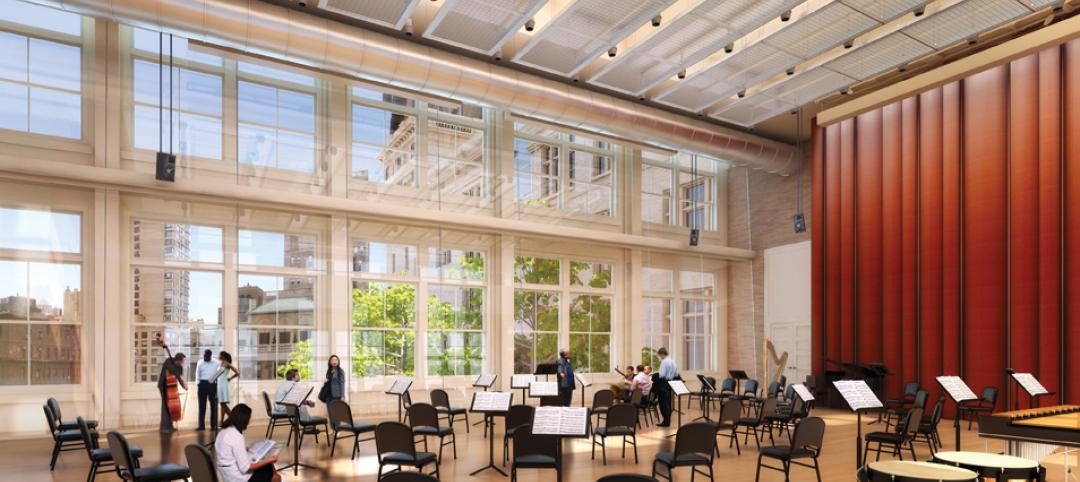Building information modeling is changing the way buildings are designed and constructed. Once regarded as the future of the industry, BIM is now being used by most Building Teams on a daily basis.In a recent survey conducted by Building Design+Construction, more than 75% of respondents indicated they currently use BIM or plan to use it. Respondents were also asked to comment on their experiences with BIM, what they liked and disliked about BIM, and what BIM-related advice they would give to their peers.
How long have you
(or your firm) used BIM?
- More than 5 years: 26%
- Never, and do not plan to use: 23%
- Less than 3 years: 18%
- 3-4 years: 17%
- Never, but plan to use: 16%
N = 115 | Note: Respondents could only make one selection.
Typical responses included: “BIM is a powerful tool for use by architects, engineers, and designers.” “BIM is a great step forward for the architectural design professional thanks to overall coordination of the design documents.” “BIM has paid for itself by saving construction labor man-hours.”
“I find BIM reduces time to create accurate construction documents and quickly produce schematic design visualization for my clients,” commented another respondent. “We’re migrating beyond adoption to companywide integration and pushing beyond that to the full supply chain spectrum to owners, trade contractors, manufacturers, architects, and designers,” added another.
Respondents also commented on their preference for a specific BIM program. “As a long-time user of BIM, we almost exclusively use Revit in all our projects.” “Revit is the only way to go. We’ve been 100% Revit for 10 years.”
Respondent opinion on BIM varied based on their user experience.
“BIM is a great tool that forces early design decisions. However, in the end it is only a tool, the project should not be held hostage by BIM.”
Another mentioned, “We’re almost moving to try to stop talking about BIM. For the first few years we were ‘pushing’; now the ‘pull’ is finally happening. It’s a shift to applied uses and values instead of discussions about technology—solving the problems of internal and external customers. It’s kind of a surprising turn of events—a shift of focus.”
Which of the following BIM programs have you (or your firm) used in the past 18-24 months?
- Autodesk Revit: 84%
- Graphisoft ArchiCAD: 6%
- Nemetschek Vectorworks: 6%
- Bentley Microstation: 4%
N = 71 | Note: Respondents could only make one selection.
BIM does have some detractors, as evidence by these comments: “The software is clearly not user-friendly—using BIM is a financial disaster for us.” “It is impossible to produce prelims that have a complete look. Information generated isn’t particularly useful and it’s not used at all in the field,” wrote another. “Until a critical mass of professionals on all levels are fully versed with BIM, it will be a very awkward process.” Others wrote, “The initial cost is out of the reach for most small practitioners. Worse than expense is the training required.”“Once in a while we have projects that are better served by AutoCAD due to availability of existing information or layouts from suppliers. However, those projects are becoming fewer. The benefits to our MEP engineers in coordination and scheduling are huge,” wrote another respondent.
Some of the specific problems related to BIM involve other members of the Building Team. “BIM does not work because subcontractors will not cooperate.” “Very few contractors are using BIM,” wrote another. “Engineers are having problems converting to BIM although we require them to use it on most projects.” “Designers need to know the project-scope point at which BIM becomes useful, and not before.” “BIM will cost the A/E community due to the extra time and expense without additional compensation. The information comes too late to coordinate and adjust drawings. Repeated computer crashes, or lock-ups, make it a miserable working environment.”
When do you use BIM?
- During schematic design, procurement, and operation: 34%
- During development of a
construction project: 32%- During pre-design: 28%
- During construction: 23%
- During post-design, pre-consultation: 18%
- All of the above: 32%
- None of the above: 31%
N = 102 | Note: Respondents could make multiple selections.
BIM USERS PROVIDE ADVICE TO INDUSTRY PEERS
A number of respondents offered some advice to other BIM users in the industry. “The true revolution in BIM will be when designers just have to hand off a model and data files to constructors and not fret over publishing 2D plans, sections, schedules, etc., from BIM.” A respondent suggested, “Design professionals need to share BIM models with owners and contractors to show them what can be done, and how it can be used. Share the model to improve the project and delivery.”
“Leverage scheduling early in the process to establish space types, pre-populate them with the appropriate objects, and model as little as possible,” commented another respondent.
Survey respondents also provided a brief glimpse into BIM’s place in the AEC industry of tomorrow. “BIM is the future and those architects that fail to get on board should consider early retirement. There needs to be more (and better) models available from suppliers.” Said another, “Any professional not using BIM will ultimately be left behind by the industry.”
MAJOR FINDINGS OF THE BIM STUDY
1. Autodesk Revit was the top choice for BIM programs, with 84% of respondents using it in the past 18-24 months.
2. BIM was used most often during schematic design, procurement, and operation (34%) and during development of a construction project (32%).
How often do building owners require BIM on one or more projects?
- Less than 25 percent: 76%
- 25-50 percent: 17%
- 50-75 percent: 4%
- Greater than 75 percent: 3%
N = 101 | Respondents could only make one selection.
3. Full support of construction documents (54%); and multidisciplinary capability serving different segments of the AEC industry (43%) were deemed the two most important general factors by respondents.
4. Construction partners that do not use BIM (50%) and clients that do not use BIM (42%) are the biggest problems faced by respondents. Training takes up too much time (37%) and the object library is not large enough/objects must be created (36%) are other problems.
5. In regard to owners that require BIM be used on their projects, 65% of respondents indicated the owners just specify that BIM be used on the project. Requiring a 3D model and clash detection using model navigation software (31%) was second most popular response.
6. Architects (47%) take most advantage of BIM-related technology followed by contractors (33%), MEP engineers (13%), and structural engineers (7%). BD+C
Related Stories
| May 18, 2011
Carnegie Hall vaults into the 21st century with a $200 million renovation
Historic Carnegie Hall in New York City is in the midst of a major $200 million renovation that will bring the building up to contemporary standards, increase educational and backstage space, and target LEED Silver.
| May 17, 2011
Redesigning, redefining the grocery shopping experience
The traditional 40,000- to 60,000-sf grocery store is disappearing and much of the change is happening in the city. Urban infill sites and mixed-use projects offer grocers a rare opportunity to repackage themselves into smaller, more efficient, and more convenient retail outlets. And the AEC community will have a hand in developing how these facilities will look and operate.
| May 17, 2011
Architecture billings index fell in April, hurt by tight financing for projects
The architecture billings index, a leading indicator of U.S. construction activity, fell in April, hurt by tight financing for projects. The architecture billings index fell 2.9 points last month to 47.6, a level that indicates declining demand for architecture services, according to the American Institute of Architects.
| May 17, 2011
Sustainability tops the syllabus at net-zero energy school in Texas
Texas-based firm Corgan designed the 152,200-sf Lady Bird Johnson Middle School in Irving, Texas, with the goal of creating the largest net-zero educational facility in the nation, and the first in the state. The facility is expected to use 50% less energy than a standard school.
| May 17, 2011
Gilbane partners with Steel Orca on ultra-green data center
Gilbane, along with Crabtree, Rohrbaugh & Associates, has been selected to partner with Steel Orca to design and build a 300,000-sf data center in Bucks County, Pa., that will be powered entirely through renewable energy sources--gas, solar, fuel cells, wind and geo-thermal. Completion is scheduled for 2013.
| May 17, 2011
Should Washington, D.C., allow taller buildings?
Suggestions are being made that Washington revise its restrictions on building heights. Architect Roger Lewis, who raised the topic in the Washington Post a few weeks ago, argues for a modest relaxation of the height limits, and thinks that concerns about ruining the city’s aesthetics are unfounded.
| May 17, 2011
The New Orleans master plan
At an afternoon panel during last week's AIA National Conference in New Orleans, Goody Clancy Principal David Dixon and Manning Principal W. Raymond Manning shared their experiences creating the New Orleans Master Plan, a document that sets a new course for the city, from land use and transportation planning to environmental protection.
| May 17, 2011
Do these buildings look like buffalo to you?
It’s hard to contemplate winter now that we’re mid-spring, but when the seasons change, ice skaters in Winnipeg will be able to keep warm in plywood shelters designed by Patkau Architects. The designers created temporary shelters inspired by animal behavior—specifically, buffalo bracing against the wind. Check them out.
| May 16, 2011
USGBC and AIA unveil report for greening K-12 schools
The U.S. Green Building Council and the American Institute of Architects unveiled "Local Leaders in Sustainability: A Special Report from Sundance," which outlines a five-point national action plan that mayors and local leaders can use as a framework to develop and implement green schools initiatives.











